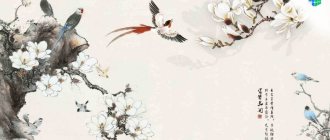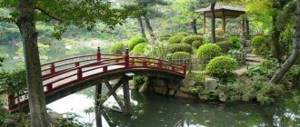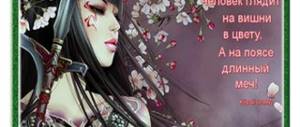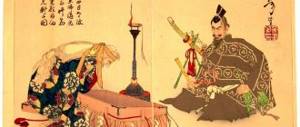| Library of practical advice |
| How to do it right |
| ⚒ |
| Fount of wisdom |
| Introduction · All Guides · Random Guide |
| Find some good advice |
| Definitions of terms |
Konniti:wa:
, my little Japanese-lover-kun (or my little Japanese-loving-chan)!
O-genki des ka?
The shell of the sacred turtle revealed to me that if you are reading these lines, then you have drunk enough sake, grown enough bonsai, performed enough tea ceremonies and created enough ikebana for the culture of the Land of the Rising Sun to permeate your belly[1] to the last appendix. And if so, she undoubtedly now urgently demands a way out, desu
. There is only one way out - hara-kiri. And this solution was found long ago by the noble samurai and the sophisticated geisha who joined them.
Usually noble samurai and sophisticated geisha, in order to give vent to emotions, engage in yaoi and hentai, contemplate cherry blossoms and draw hieroglyphs on rice paper. But what if sakura doesn’t grow in your area, you don’t know the hieroglyphs, and you didn’t bring rice paper to the Stationery store? Masaka!
There is only one way out - hara-kiri. Well, there is another truly Japanese way to express your sublime feelings. This is a haiku essay.
Just tell yourself: Dekimas!
And - banzai, may the bright Amaterasu and this manual help you!
And yes - don't forget to call me sensei
.
Content
- 1 Sa: hajimemase:
, or Let's begin! 1.1 Preparation
- 3.1 Title
- 4.1 What to write about?
- 5.1 Examples of haiku in Japanese
, or Congratulations!
What is haiku and how is it different from haiku?
Haiku is a traditional Japanese verse that emerged as a genre in the 16th century. Haiku was at first the initial part of the poetic form of “tanka”, and then the Japanese liked composing “three-line poems” so much that such a genre arose.
Haiku is a modern name, proposed in the 19th century to avoid some confusion. Therefore, we will call them that way. (Although somewhere you can find the old name, as well as disputes about the differences. This is how I understand it, experts can correct me.)
A haiku is a lyric poem consisting of three verses: the first and last are five-syllable, and the second is seven-syllable. There are 17 syllables in total in the poem. This rule exists only for the Japanese language. When translating, the number of syllables changes because languages differ in the semantic load of words.
Sa: hajimemase:, or Let's begin![edit]
Preparation[edit]
Canonical attire for writing haiku Even more canonical attire for writing haiku But this is not good... The great Japanese poet Wasabi Tiramisu in work clothes carries retribution in the name of the Moon preparing to start writing haiku Writing haiku
must be carefully prepared. First of all, you should get into a contemplative mood. Put everything aside for a while. Do one or two hara-kiri. Eat fugu. Catch and kill several Pokemon. Watch 100-200 anime episodes without translation. Wear a kimono or sailor fuku.
Wonderful! Katajikenai!
Now you are ready for the sacrament of hokkusposition.
Form[edit]
It would seem that you are already sporting a sailor fuku - what other uniform is needed? But you're not the only one who needs a form. Haiku also requires a certain, canonical form, desu
.
Title[edit]
Coming up with a good name is half the battle. According to the rules, a proper title should be 2-3 times longer than the haiku itself in order to contain as many details as possible about your life and state of mind at the time of writing. It is also very good to mention yourself (it is not forbidden to use the third person). It is important to use as many words as possible like “remember”
(especially -
“remembering the past time”
),
“sad”
,
“wandering”
,
“contemplating”,
etc., as well as mentions of the customs of common people or the beauties of nature.
What do you want? Haiku is lyrics, fuck desu
.
For example, here are a few successful names from the classics:
- “I remember the past while collecting young herbs”
- “From songs to my beloved, sent with orange flowers”
- “I’m sad, alone, in a hut, having buried my friend - the monk Dokkai”
- “When I lived in Saga, the scent of plums came to me from the monastery garden on the other side of the road.”
And - a couple of masterpieces performed by Basho himself:
- “I lived a miserable life in the city for nine years and finally moved to the outskirts of Fukagawa. One person wisely said in the old days: “The capital Chang'an has been the center of fame and wealth since ancient times, but it is difficult for someone who does not have money to live in it.” I think so too, for I am a beggar.”
- “I’m sad looking at the moon; I am sad, thinking about my fate; I'm sad that I'm so inept! But no one will ask me: why are you sad? And I, being lonely, feel even sadder.”
Yes, these were also haiku names. Suteki
, is not it?
Size[edit]
Remember once and for all: proper haiku has 3 (three!) lines! Three! Not two, not seven and not forty-two. Only Darth Herohito could compose haiku with a floating dimension of the number of lines (2, 4 and even 5). But for ordinary poets (even brilliant ones), three lines is a constant bar.
The great Japanese poet Mayakobusuke-san said this well:
* * *
We say “three”, We mean “haiku”. The reverse is also true.
And it’s not for nothing that another great Japanese poet Goguryo-san exclaimed:
* * *
Oh three, Bird - three! Who invented you?
Unfortunately, in modern Russia there are too many fake Chinese-made haiku (mostly four- and five-line ones) being distributed. Example:
Li Bo. "Yu"
Yes tou, yes tou, Xia yu bu chou. Ren Jia Yu San, Ni Yu Da Tou.
Abunai!
Once again: this is not real haiku. Don't be fooled.
For a long time it was believed (mainly by the Japanese) that classical haiku should have exactly 17 syllables, arranged in a 5-7-5 pattern. This caused objections from German poets, since this rule did not allow them to compose haiku in German - after all, the average German word contains 54,308,428,790,203,478,762,340,052,723,346,983,453,487,023,489,987,231,275,412 390,872,348,475 syllables (cm . German
). Since Japan was an Axis ally of Germany at that time, Emperor Herohito allowed the syllable limit to be lifted; For this, the Germans gave Japan a pocket aircraft carrier.
In general, now the number of syllables in haiku can no longer be counted. But brevity is still welcome - after all, it is s.t.!
LiveInternetLiveInternet
HAIKU AND HOKKU - CAUTION! DON'T BE CONFUSED!
I am publishing the article by Yuri Runov in full, because... she is interesting and informative. Enjoy reading! I have already written before that many people do not understand about haiku and haiku that these are not synonyms. Which is what I want to write about in more detail, and at the same time about where haiku came from. In principle, many people read something on this topic, but somewhere some significant points often slipped past the reader’s consciousness, which gave rise to disputes, struggles of self-conceit, etc. BACKGROUND OF HAIKU The progenitor of haiku, as is known, is tanka - and more specifically, its first tercise. I was surprised to learn how early this division of the tank into three and two lines began. It turns out that already the great tanka poet Saigyo took part in stringing the stanzas - and this is the 19th century. One poet wrote the first three lines, another added two lines to form a thangka, but at the same time both the couplet and the tercet had to be read as separate verses. Then the first poet or the third wrote the next tercet which, with the previous couplet, would form the “reverse” tanka - i.e. First, a new tercet was read and the previous two lines were added to it for a complete tank. Next is a new couplet, etc. And even then, individual themes were assigned to individual stanzas in the collective work of poets. There is a well-known story when his acquaintances poets came to Saiga and complained that no one knew how to continue the chain of stanzas after this stanza dedicated to the war, the famous poetess of that time Hee no Tsubone: The battlefield is illuminated - The month is a tightly drawn bow. Here Saige himself wrote a new stanza: He killed the heart within himself. Has the hand become friends with the “ice blade”, Or is it the only light? Why not haiku? Now read this stanza, adding the poetess’s couplet after it. Here comes the tanka... Over the next few centuries, this stringing of stanzas became increasingly popular and somewhere around the 16th century it became a favorite pastime of the literate population of Japanese cities. But the more popular it became, the less poetry remained in it - writing renga became a pastime where humor, ridicule, and various verbal tricks were valued. Therefore, this type of poetry began to be called haikai - i.e. humorous mixture. At the beginning of the 17th century, the term haiku (comic poem) also appeared, but then, however, it was forgotten for several hundred years. At this time, individual tercets are already written - not as part of the renga. There are even competitions to see who can write the most haiku in a certain period of time - for example, in a day. The results were phenomenal, but no one really cared about the quality of such poems. HOKKU Then came Basho, who elevated “comic rhymes” to the level of deep poetry. And here the differences between haiku and other types of tercets begin to appear. Haiku was the opening verse of renga and had fairly strict rules applied to it. It had to be connected with the season - because the ranks were divided according to the seasons. It had to be “objective”, i.e. based on the observation of nature and should not have been “personal” - for this was not the renga of Basho or Ransetsu - but the collective work of poets. Complicating elements - metaphors, allusions, comparisons, anthropomorphism were also not allowed here. Etc. Just everything that haiku experts in the West consider to be the unshakable rules of haiku. This is where the confusion with haiku and haiku begins. With all this, haiku had to carry a powerful aesthetic charge - set the tone for the entire chain of strung stanzas. They were written in advance for all possible seasons. Good haiku were highly valued because they were difficult to write - they required real skill, and so many people wanted to write renga. Then the first collections of haiku appeared - specifically to satisfy the mass demand for the initial stanzas. Collections of internal renga tercets simply could not be written in advance - they were created only in response to the previous stanza in the real renga and therefore there were never collections of these stanzas, except in the renga themselves. HOKKU AND OTHER TERCEPTHS But here you need to understand that all the great haiku masters took part in the creation of renga and wrote not only haiku but also the internal verses of renga - which incredibly expanded the possibilities of tercets - there were tercets that the poet was obliged to write in the first person, there were poems about human affairs and not about nature, both metaphors and anthropomorphization were allowed and used; kigo and kireji became optional in many stanzas. In addition, haiku were composed both as diary entries, and as a gift from a poet to an acquaintance or friend, and as responses to various events. Haiku-like verses and simple stanzas could also be used here. And all this was united by the common concept of haikai poetry - which, after a couple of centuries, Shiki would replace with the term haiku, which he revived. There’s no way you can write down in haiku this tercet written by Basho while visiting an exhibition of his friend’s drawings: You’re a so-so artist, but this bindweed of yours is truly as if it’s alive! A STRAITJACKET IS PUT ON A HAIKU Since the first Western researchers dealt only with collections of haiku, they ignored all other types of tercets and thus established the rules of haiku as the rules of haiku. This is where the ridiculous restrictions imposed to this day on haiku by many authorities in the West came from. After all, some there still consider Issa to be an unbalanced rebel, whose deviations from the “haiku norms” only confirm that they are right, just as exceptions confirm the rules. But Issa was not a rebel at all, he simply at times went beyond the boundaries of haiku, but not haikai poetry - or haiku in the new terminology. By the way, in his famous “Snail on the Slope of Fuji” he, of course, does not look at a real snail on the slope of a real Fuji, but at a snail on a model of Fuji - a sacred mountain - installed in many Japanese temples - this again is not some kind of thoughtful surreal the poem is a sweet joke from the great master of haiku. However, everyone is free to see whatever they want in a poem; these are the rules of the game of haiku. DOWN WITH HOKKU In Russia, we are in an incomparably more advantageous position than in the West - in all our collections of haiku by great masters, there are not only haiku, but also poems from diaries, poetic offerings, tercets from renga. That’s why we never created these sets of laws for haiku. The only thing that we confuse is haiku and haiku - you can still read “My Hokku” on the websites of our enthusiasts, where there may not be a single poem at all that would have the right to be called haiku (there are no seasonal words, there are no kireji, but there are metaphor, etc.) I would completely abandon the term haiku, as it confuses the brain, and would leave one term - haiku. Haiku is only useful for writing renga. And there everything should be according to the rules, unless we come up with new ones ourselves! (c) Yuri Runov
In Russia, we are in an incomparably more advantageous position than in the West - in all our collections of haiku by great masters, there are not only haiku, but also poems from diaries, poetic offerings, tercets from renga. That’s why we never created these sets of laws for haiku. The only thing that we confuse is haiku and haiku - you can still read “My Hokku” on the websites of our enthusiasts, where there may not be a single poem at all that would have the right to be called haiku (there are no seasonal words, there are no kireji, but there are metaphor, etc.) I would completely abandon the term haiku, as it confuses the brain, and would leave one term - haiku. Haiku is only useful for writing renga. And there everything should be according to the rules, unless we come up with new ones ourselves! (c) Yuri Runov
Contents[edit]
When contemplating this picture, the average Japanese is able to add up to 1010101110111010 haiku.
None of them will mention red flowers and blue mountains. 99.9% of haiku is dedicated to this landscape. The remaining billion is dedicated to sakura petals and the reflection of the moon in the water. The content of haiku should combine brevity, grace and philosophical depth. It is considered especially chic to start in health, and end for the repose of devoting the first two lines to one plot, and in the third SUDDENLY
talk about something else, thereby giving an unexpected interpretation and returning the meaning to the beginning.
It’s also good to suddenly stop the train of thought, SUDDENLY
making the reader wonder what the author really wanted to say.
In general, good haiku is always SUDDEN
.
This is the Tao, desu
.
This haiku rule is perfectly illustrated by the great Japanese poet Makukarutenyo-san:
“I’m sad about yesterday, when all sorrows seemed so far from me”
Oh I believe In yesterday SUDDENLY!!
What to write about?[edit]
Yes about everything. The point of haiku is that it is not reality that matters, but your experiences. Which, in turn, must be expressed through some objects of reality.
The less these objects fit your feelings, the better (I remind you once again: good haiku is SUDDEN!
). Since the experiences of the haiku author are always sublime, it is best to express them through all sorts of rubbish. For example, the feeling of love can be expressed through crickets, nostalgia - through a straw broom, and aesthetic pleasure - through the ass through a toad in a pond. These are the laws of the genre.
The exceptions are the moon, sakura and Fuji. Everything can be expressed through them.
In extreme cases, you can not express anything, but simply whine and complain about fate. This is also very much appreciated.
A few selected haiku by famous Japanese poets[edit]
Mikairu Rerumonetobu. “Wandering through the snowy country, I remember the lost capital”
Tell me, uncle-san, is it not for nothing that Moscow, burned by fire, was given to the Frenchman?
Kamikaze Fussiken. “On the seashore I reflect on the immutability of nature”
There is a green oak near the Lukomorye, a golden chain on that oak tree, day and night...
Kamikaze Fussiken. “Sitting with a glass, I lament human futility”
God forbid I go crazy. No! Lighter staff and sumo...
Sasya Buroku. “Sometimes I come home drunk in the dark. Got lost..."
Night, street, lantern, pharmacy. Night, icy ripples of the canal. Pharmacy, street, street lamp...
Sasya Shorune. “I listen to the cry of a child punished with a bamboo stick for getting a D+”
There are cockroaches in the kitchen, leaving the black bread, thinking a little...
Advice
You may have come to this page having already enjoyed the classic masterpieces of Emperor Darth Herohito.
His immortal creations inspire every connoisseur of beauty and even inspire a desire to try to surpass their author, don’t they? Alas! Only Chuck Norris managed to surpass Darth Herohito, and even then only in one discipline, and no one can surpass him in the composition of haiku. So desu nee...
What sadness! There is only one way out - hara-kiri. But you can try to at least get closer to the unattainable ideal. As Bushido says, the goal of the path is not in achieving the goal of the path, but in the process of achieving it.
Iban Turogenyobu. “In days of doubt, in days of painful thoughts, I feel sad about the fate of my homeland.”
How not to fall into despair when you see what is happening at home?
Shiroju Yoshinen. “In a village tavern, a rogue cook served me incorrectly prepared fugu fish.”
I have only one fun left: Fingers in the mouth...
What should a real haiku be like?
Having dealt with the formalities (or not, let’s leave this question to linguists, Japanese scholars and other “aesthetes”), let’s move on to the main thing.
The verse presents a small picture of the world Photo: Depositphotos
How to distinguish haiku from “pseudo-haiku” and other “fakes”?
- The main thing to remember is that haiku are short .
- Usually two images or two objects are used and the dynamics of their relationship are conveyed.
- Human life is often depicted against the backdrop of nature and the changing seasons (in classical haiku this is generally a natural image that is somehow connected with a person).
- The verse presents a small picture of the world , but it is part of the overall canvas.
- The authors of the poems tried not to describe changes in nature, but to show it at a given moment in time . But in a moment everything can change!
- Poets assigned a large role to subtext in verse. Understatement is present in every poem.
Masters of Japanese poetry said:
“Look at the familiar - you will see the unexpected, look at the ugly - you will see the beautiful, look at the simple - you will see the complex, look at the particles - you will see the whole, look at the small - you will see the great!”
For a greater “immersion effect,” each poem can now be printed on a separate page. Can you imagine? In a word, Japan...
So, the main features of Japanese haiku are: conciseness, attention to detail, understatement.
Of course, significant “liberties” may now appear. In some cases, “haiku” can turn into “pseudo-haiku.” That is, poems in the style of haiku. But everything has a right to exist.
The main features of haiku are laconicism, understatement, and attention to detail Photo: Depositphotos
Haiku in Japanese[edit]
Haiku (side view)
Composing haiku in Japanese is very Japanese, desu!
Japanese haiku differs from Russian haiku in that they are Japanese.
If you have already mastered the above exercises, it will not be difficult for you to compose real Japanese haiku. Yokatta!
Do everything exactly the same, only use Japanese instead of Russian words.
I hope nihongo-ga dekimas ka?
Examples of haiku in Japanese[edit]
The samurai goes around the country, wanting to dispel the autumn sadness
Osshu-sha crap Hoju tamaishama, hiccup Isshu sake naharyavu
In a foreign land I remember my homeland, contemplating the whirling of falling leaves
Samurai bitches Shirote sake-ne nariri Hoshu domoi
Kakkoi kawaii
[2], isn't it?




